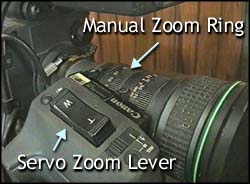Video Camera Zooming
The zoom is the function which moves your point of view closer to, or further away from, the subject. The effect is similar to moving the camera closer or further away. (It isn't quite the same as moving the camera though. More on that later.)
The two most common zoom mechanisms are shown below:

- Manual zoom (ring). This is a zoom ring on the lens housing which is rotated manually, typically by the left thumb and index finger.
Advantages: Speed (you can do super-fast zooms); doesn't require power (so no drain on your battery).
Disadvantages: More difficult to control; harder to get smooth zooms. - Servo zoom (lever). This is a lever which sits on the lens housing. It's usually positioned so that when you slide your right hand into the grip belt, the servo zoom will be sitting under your first two fingers. Pressing the front part of the lever zooms in, pressing the rear part zooms out. Cheaper cameras usually have a constant zoom speed, whereas a good servo zoom will have variable speed -- the further you depress the lever, the faster the zoom. The lever may have labels such as T and W (tele and wide).
Advantages: Easy to use in most situations; nice smooth zooms.
Disadvantages: Uses battery power; may be limited to fixed speeds.
There's an important characteristic of zoom lenses that you should be aware of: The further you zoom in, the more difficult it is to keep the picture steady. At very long zooms, a tripod is essential. If you're having trouble keeping your shot steady, it may be possible to move yourself closer to the subject and then zoom out. This way you'll have essentially the same framing, but much steadier.
Zooming is the function everyone loves. It's easy and you can do lots with it, which is why it's so over-used. The most common advice we give on using the zoom is use it less. It's a great tool in moderation, but when most of your shots are zooming in and out, your audience will feel nauseous.
As a rule, don't zoom unless there is a reason to. If you want to show both the whole scene as well as some close-up details, you don't need to have a zoom in. Instead, shoot a wide shot, stop recording, zoom in to a close up, then start recording again. The result is one shot which cuts cleanly and quickly to another, portraying the same information as a zoom, but more efficiently.
See also: Digital vs optical zoom